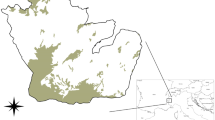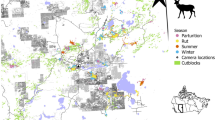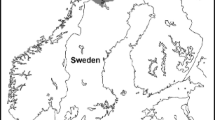Summary
A small caribou herd of 24–77 animals resided on Pic Island (1138 ha) in Lake Superior from 1976 to 1984. Most of the caribou populations on the adjacent mainland had gone extinct earlier in this century. We tested three hypotheses for the persistence of this remanant population: (1) there was more forage available on the island than the mainland, (2) the animals on the island were isolated from white-tailed deer and did not develop the meningeal worm infection, and (3) there was less predation by wolves on the island. Forage was more abundant on the mainland than on Pic Island. The eggs of meningeal worms were not found in the feces of deer on the mainland or Pic island. Wolves seldom visited the island and when they did there was escape habitat available for the caribou. We concluded that the herd persisted because of this reduced predation risk and that the animals were prepared to select a reduced variety and phytomass of forage to remain for long periods in the relatively safe island habitat. When the animals did visit the mainland to feed they sclected forbs that provided a large bite size. On the island food supplies were too meager to select plants that gave a large bite size and the caribou spent long intervals feeding. Caribou by using habitats with a large phytomass and selecting for large bite size should minimize their time feeding which would allow them more time to watch for predators.
Similar content being viewed by others
References
Anderson RC (1972) The ecological relationships of meningeal worm and native cervids in North America. J Wildl Dis 8:304–309
Andrewartha HG, Birch LC (1954) The distribution and abundance of animals. University of Chicago Press, Chicago, Illinois, p 782
Andrewartha HG, Birch LC (1984) The ecological web. University of Chicago Press, Chicago, Illinois, p 506
Arman P, Hopcraft D, McDonald I (1975) Nutritional studies on East African herbivores. Losses of nitrogen in feces. Brit J Nutrit 33:265–275
Arnold GW (1970) Regulation of food intake in grazing ruminants. In: Phillipson AT (ed) Physiology of digestion and metabolism in the ruminant. Oriel Press, Newcastle, England, pp 165–176
Belovsky GE (1978) Diet optimization in a generalist herbivore: the moose. Theo Pop Bio 14:105–134
Belovsky GE (1984) Herbivore optimal foraging: a comparative test of three models. Am Nat 124:97–115
Bergerud AT (1971) Abundance of forage on the winter range of Newfoundland caribou. Can Field Nat 85:39–52
Bergerud AT (1972) Food habitats of Newfoundland caribou. J Wildl Manage 36:913–923
Bergerud AT (1974) The decline of caribou in North America following settlement. J Wildl Manage 38:757–770
Bergerud AT (1985)Antipredator strategies of caibou: dispersion along shorelines. Can J Zool 63:1324–1329
Bergerud AT, Butler HE, Miller DR (1984) Anti-predator tactics of calving: dispersion in mountains. Can J Zool 62:1566–1575
Bergerud AT, Elliot JP (1986) Dynamics of caribou and wolves in northern British Columbia. Can J Zool 64:1515–1529
Bergerud AT, Manuel F (1968) Moose damage to balsam fir-white birch forests in central Newfoundland. J Wildl Manage 32:729–746
Bergerud AT, Nolan MJ, Curnew K, Mercer EM (1983a) Growth of the Avalon Peninsula, Newfoundland caribou herd. J Wildl Manage 47:989–998
Bergerud AT, Wyett W, Shider B (1983b) The role of wolf predation in limiting a moose population. J Wildl Manage 47:977–988
Boertje RD (1981) Nutritional ecology of the Denali caribou herd, MSc thesis Univ of Alaska, Fairbanks, AK, p 293
Boertjc RD (1985) Seasonal activity of the Denali caribou herd, Alaska. Rangifer 5:32–42
Bracher GA, Meredith TC (1985) Landsat imagery and range evaluation for Ungava. In: Meredith TC, Martell AM (eds) 2nd North American Caribou workshop. McGill Subarctic Research Paper No. 40. McGill University, Quebec, pp 33–46
Burnham KP, Anderson DR, Laake JL (1980) Estimation of density from line transect sampling of biological populations. Wildl Monog No. 72
Butler HE (1986) Mating strategies of woodland caribou (Ranifer tarandus caribou). PhD thesis University of Calgary, Calgary, Alberta, Canada
Chapman LJ, Thomas MK (1968) The climate of northern Ontario. Climatological studies, No. 6. Department of Transport, Meteorological Branch, Ottawa
Clutton-Brock TH, Guinness FE, Albon SD (1982) Red deer: behavior and ecology of two sexes. University of Chicago Press, Chicago, p 378
Connell JH, Sousa WP (1983) On the evidence needed to judge ecological stability or persistence. Am Nat 121:789–824
Cringan AT (1957) History, food habits and range requirements of the woodland caribou of continental North America. Trans of the North Am Wildl Conf 22:485–501
Cumming HG, Beange DB (1987) Dispersion and movements of woodland caribou near Lake Nipigon, Ontario. J Wildl Manage 51:69–79
Damman WWH (1964) Some forest types of central Newfoundlland and their relation to environmental factors. Forest Research Branch Contribution No. 596, Forest Resources Board, Department of Forestry, Ottawa, p 62
Darby WR, Duquette LS (1986) Woodland caribou and forestry in northern Ontario, Canada. Rangifer, Special Issue No. 1:87–93
Eberhardt LL (1978) Transect methods for population studies. J Wildl Manage 42:1–31
Edwards J (1983) Diet shifts in moose due to predator avoidance. Oecologia (Berlin) 60:185–189
Erskine JS (1957/58) Shell-heap archeology of southeastern Nova Scotia. Proceedings of the Nova Scotia Institute of Science. 24:339–375
Ferguson SH (1982) Why are caribou on Pic Island? M Sc thesis, Univ of Victoria, Victoria, British Columbia, Canada. p 171
Floyd TJ, Mech LD, Jordan PA (1978) Relation wolf scat content to prey consumed. J Wildl Manag 42:523–532
Gates CC, Hudson RS (1981) Weight dynamics of wapiti in the boreal forest. Acta Theoriological 27:407–408
Gates CC, Adamczewski J, Mulders R (1986) Population dynamics, winter ecology and social organization of Coats Island caribou. Arctic 39:216–222
Gauthier DA, Farnell RF (1986) Comparison of caribou physical characteristics from Yukon and neighboring caribou herds. Rangifer Special Issue No 1:131–135
Gatter J (1950) The moose of central British Columbia. Ph D thesis. University of British Columbia, Vancouver, British Columbia, Canada
Hebert DM (1973) Altitudinal migration as a factor in the nutrition of bighorn sheep. Ph D thesis. Univ of British Columbia, Vancouver, British Columbia, Canada, p 356
Keith LB (1983) Population dynamics of wolves. Pages 66–77. In: LN Carbyn (ed) Wolves in Canada and Alaska. Canad Wildl Service Report Series No 45
Kolenosky GB (1983) Status and management of wolves in Ontario. In: Carbyn LN (ed) Wolves in Canada and Alaska. Can Wildl Ser Rep Ser No 45 pp 35–40
Lankester MW, Crichton VJ, Timmerman HR (1976) A protostronglylid nematode (Strongylidae:Protostrongylidae) in woodland caribou (Rangifer tarandus caribou). Can J Zool 54:680–684
Leader-Williams N, Scott TA, Pratt RM (1981) Forage selection by introduced reindeer on South Georgia, and its consequences for the flora. J Appl Ecol 18:83–106
Leslie DM, Starkey EE (1985) Fecal indices to dietary quality of cervids in old-growth forests. J Wildl Manage 49:142–146
Lieb JW, Tobey RW, Eide SH (1985) Analysis of Nelchina caribou range. Alaska Department of Fish and Game. Prog Rept W-17-3. Anchorage, Alaska, p 143
Lima SL, Valone TJ, Caraco T (1985) Foraging-efficiency predation-risk trade-off in the grey squirrel. Anim Behav 33:155–165
Morse DH (1980) Behavioral mechanisms in ecology. Harvard Univ Press. Cambridge, Massachusetts, USA, pp 383
Murdoch W, Scott MA, Ebsworth P (1984) Effects of the general predator Notonecta (hemiptera) upon a freshwater community J Anim Ecol 53:791–808
Murdoch W, Scott MA (1984) Stability and extinction of laboratory populations of zooplankton preyed on by the black swimmer Notonecta. Ecol 65:1231–1248
Nieminen M, Kellokumpu S, Vayrynen P, Hyvarinen H (1980) Rumen function of the reindeer. In: Reimers E, Gaare E, Skjenneberg S (eds) 2nd Intern Reindeer/Caribou Symp Roros, Norway, 1979 Direktoratet for vilt og ferskvannsfisk, Trondheim. pp 213–223
Nixon MA (1982) Enery maximizers and time minimizers: theory and reality. Am Nat 119:596–599
Overton WS, Davis DE (1969) Estimating the numbers of animals in wildlife populations. In: Giles RH (ed) Wildl Manage Techniques, 3rd ed The Wildlife Society Washington, DC pp 403–455
Peterson RL (1955) North American moose. Toronto University Press, Toronto, Canada
Peterson RL (1966) The mammals of eastern Canada Oxford Univ Press, Toronto, p 485
Pyke GH (1984) Optimal foraging theory: a critical review. Ann Rev Ecol Syst 15:523–575
Pyke GH, Pulliam HR, Charnov EL (1977) Optimal foraging: a selective review of theory and tests. Quart Rev Biol 52:137–154
Reimers E, Villmo L, Gaare E (1979) Rangifer in Norway including Svalbard. In: Reimers E, Gaare E, Skjenneberg S (eds) 2nd Inter Reindeer/Caribou Symp Roros, Norway Direktoratet for vilt og ferskvanssfisk, Trondheim, pp 774–785
Renecker LA, Hudson RJ (1985) Estimation of dry matter intake of free-ranging moose. J Wildl Manage 46:785–792
Roby DD (1978) Behavioural patterns of barren-ground caribou of the Central Arctic Herd adjacent to the Trans-Alaska oil pipeline. MSc thesis. Univ of Alaska, Fairbanks, Alaska, p 200
Schoener TW (1971) Theory of feeding strategies. Ann Rev Ecol Syst 2:369–404
Scotter GW (1964) Effects of forest fires on the winter range of barren-ground caribou in northern Saskatchewan. Can Wildl Ser, Wildl Manage Bull Ser No 1 p 111
Segal AN (1962) The periodicity of pasture and physiological functions of reindeer. Severnio-len'v Karel'skoi ASSR. Academie Nauk SSSR. Moscow Translated by the Can Wildl Ser, Ottawa, p 179
Simkin DW (1965) A preliminary report of the woodland caribou study in Ontario. Ontario Dept of Lands and Forests, Sec Rept (Wildlife) No 59 p 76
Skogland T (1984) Wild reindeer foraging-niche organization. Holarctic Ecol 7:345–379
Skogland T (1985) The effects of density-dependent resouce limitation on the demography of wild reindeer. J Anim Ecol 54:359–374
Skogland T (1986) Desnity dependent food limitation and maximal production in wild reindeer herds. J Wildl Manage 50:314–319
Stephens DW, Krebs JR (1986) Foraging theory. Princeton Univ Press, Princeton, New Jersey USA, p 247
Telfer ES, Kelsall JP (1984) Adaptations of some large North American mammals for survival in snow. Ecol 65:1828–1834
Trainer DO (1973) Caribou mortality due to the meningeal worm (Parelaphostrongylus tenuis). J Wildl Dis 76:378
Van Ballenberghe V, Erickson AW, Byman D (1975) Ecology of the timberwolf in northeastern Minnesota. Wildl Monogr No 43 p 43
Williamson VHH (1951) Determination of hairs by impression. J Mamm 32:80–84
Author information
Authors and Affiliations
Rights and permissions
About this article
Cite this article
Ferguson, S.H., Bergerud, A.T. & Ferguson, R. Predation risk and habitat selection in the persistence of a remnant caribou population. Oecologia 76, 236–245 (1988). https://doi.org/10.1007/BF00379957
Received:
Issue Date:
DOI: https://doi.org/10.1007/BF00379957




